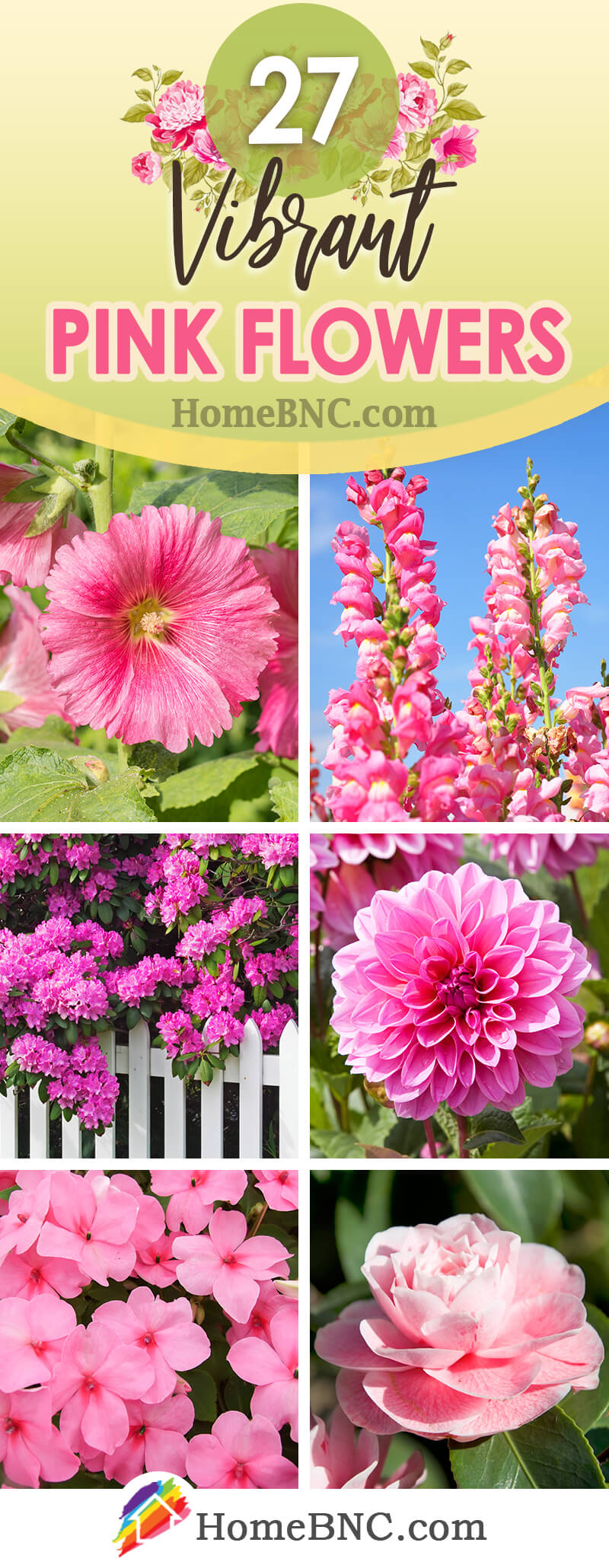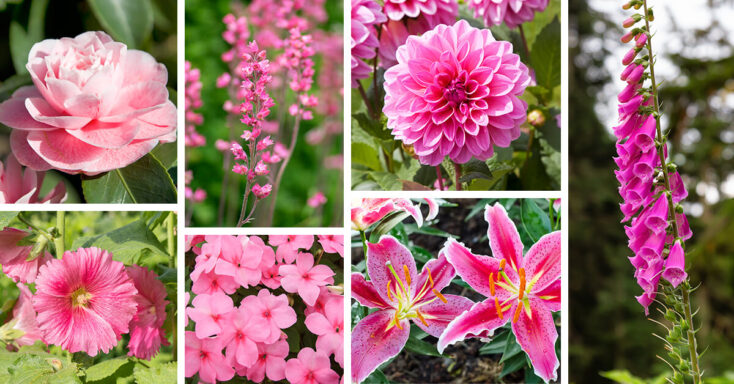Spring is right around the corner, and it’s never too early to start thinking about your garden, and the possibility of adding different types of pink flowers to your color scheme. Even if you have acres of rosebushes or just a small patch of greenery in a garden home, springtime gardening is an enjoyable pastime for many. A small apartment balcony can be easily transformed into a riot of color by strategically placing flower pots. Flower beds can be transformed into rainbows of various colors. Some prefer more primary colors, but there is something about the color pink that says “spring has arrived.” Some people prefer a more uniform arrangement of flowers in their gardens, while others prefer a riot of color.
The 27 Top Delightful Pink Flowers for Your Garden
Regardless of the size or scope of your project, you should first plan out what you want to accomplish, which may include a trip to the Arboretum or a nursery to get an idea of what plants are available and how they should be arranged. There is no shortage of flowers in various sizes and shapes if you decide to make your spring garden’s color scheme pink this year. Light pink flowers have a light, airy feel and can serve as a neutral, but bright or hot pink blooms add drama. Look no further than this gallery to find a plethora of pink options!
1. Coral Bells (Heuchera)
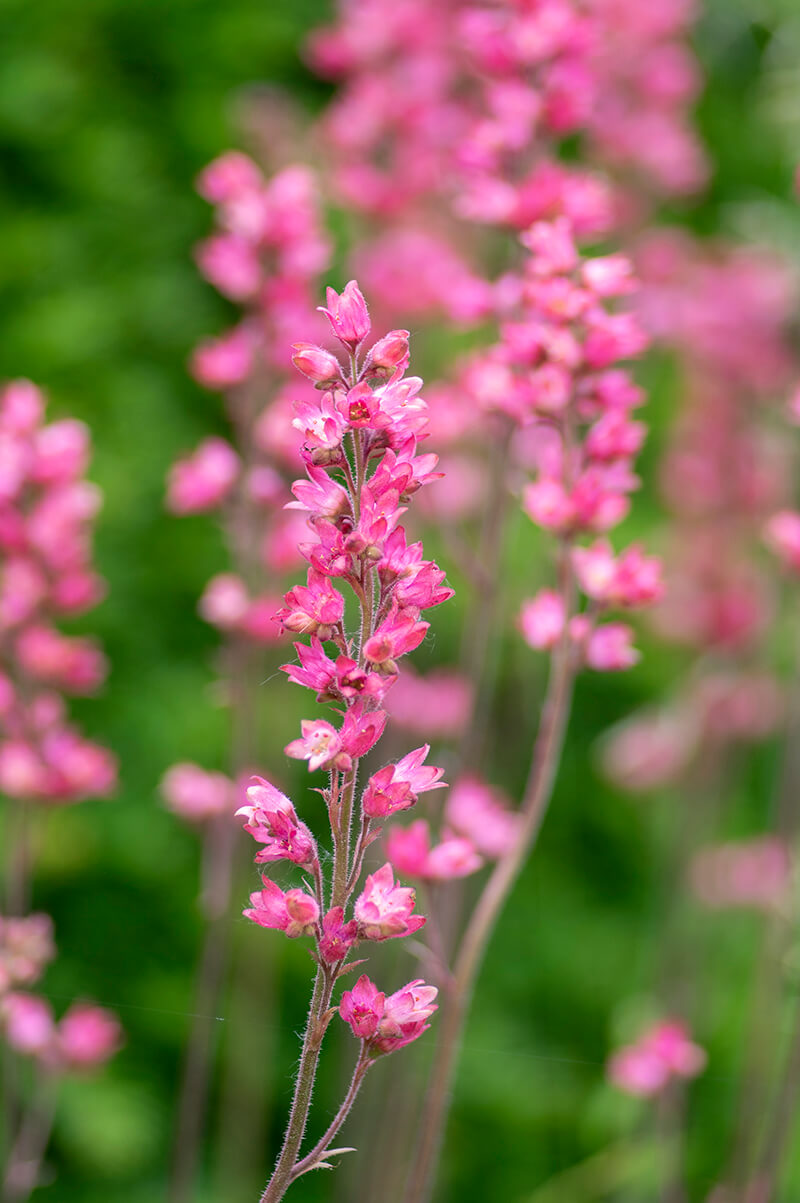
This stunning North American native is available in a wide range of colors and varieties, including a variety of types of pink flowers. Bell-shaped flowers bloom in spring and early summer at the ends of long stems that sprout from a woody rootstock. Bees and hummingbirds are drawn to nectar-rich plants like this one, making it a good choice for gardens that cater to them. The evergreen leaves have a rounded shape. They thrive in rock gardens and container gardens if planted in the fall, and they grow at a moderate pace.
In honor of Johann Heinrich Heuchera, a German botanist who lived in the early 1800s, the genus Heuchera was given its scientific name. The bell-shaped flowers, which hang from swaying stems, are what gives coral bells their common name. Coral red flowers became associated with Mary and white coral bell flowers with Jesus’ purity in Catholic households. Soil should be rich but well-drained, and it should be planted in full sun to part shade. There should be no more than a tinge of acidity in the soil. A summer bloomer, it thrives in USDA zones 4-8.
2. Impatiens (Impatiens Walleriana)
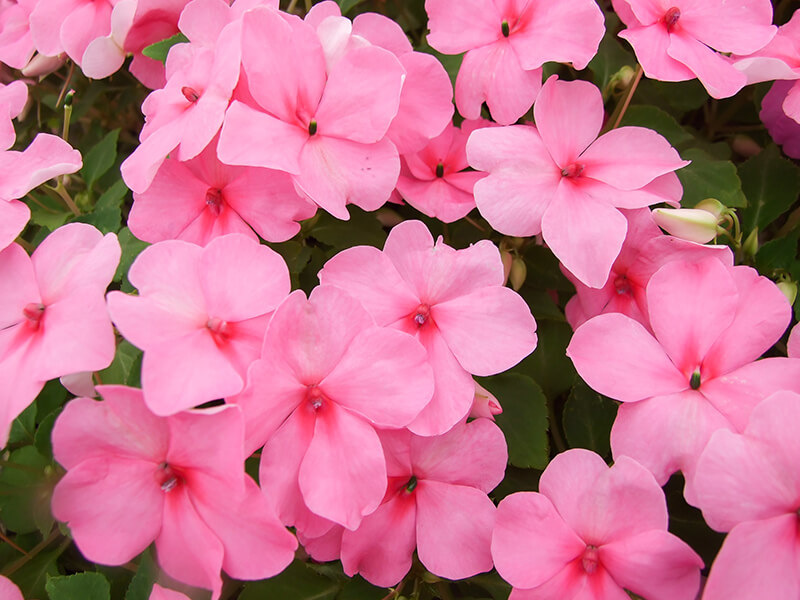
Impatiens have been in nearly every garden in the Northern Hemisphere at some point. These easy-to-grow, shady-area-friendly flowers, native to Africa and Eurasia, come in a rainbow of hues, from white to pink to blue. With some varieties barely rising above the ground, they are among the tiniest plants in your garden. A typical planting date is Memorial Day in the United States; the plants will begin blooming in late spring or early summer. Impatiens are considered a flower of motherly affection. Impatiens, as the name suggests, are associated with impatience in some cultures. It thrives in rich, well-drained soil that is slightly acidic in its pH range. Zones 10-11 are ideal for growing it, and it prefers partial to full shade. It’s best to water them once a week, and they’ll thrive in pots and hanging baskets.
3. Dahlias (Dahlia)
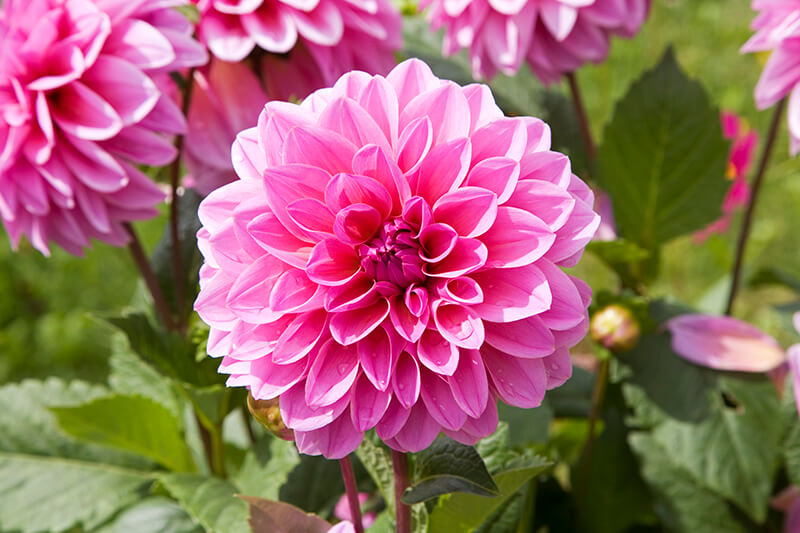
In the middle of summer, the dahlia flower, with its starburst leaves and rainbow colors, including a vivid shade of pink, comes into bloom. It is native to Central and South America, and can grow up to six feet in height in some cases. They can be treated as a perennial in mild climates and left in the ground, but they need to be dug up and stored if the ground temperature drops below 20 degrees Fahrenheit. Rich in symbolism, the dahlia symbolizes a variety of emotions, from wealth and elegance to love and commitment.
The Dahlia was not only a food item for the Aztecs, it also served as a religious symbol and was employed in a variety of rituals. Zones 8–10 are the best for growing it, but it can be grown in zone 7 with the proper precautions. There must be a lot of sunlight and an acidic soil, as well as well-drained, loose soil. Once the tubers start showing green growth, it’s okay to water them once or twice a week after that.
4. Azaleas (Rhododendron)
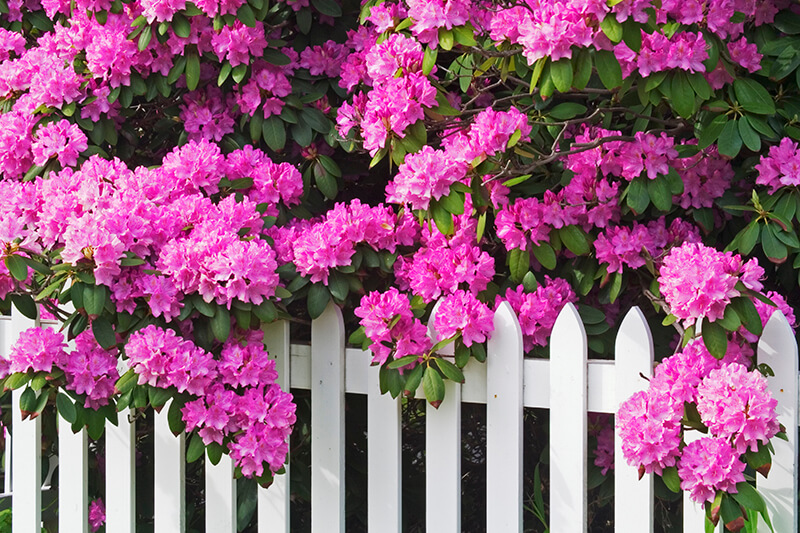
This flowering azalea shrub is the most common sign of spring in the southern United States.The most popular flower color is a vivid pink, but these plants can produce flowers in a variety of white, red, and pink hues. While most azaleas bloom from the middle of spring to the end of April, depending on the weather, some can bloom as early as March. In spite of the fact that azaleas and rhododendrons have been used interchangeably, the azalea blooms more evenly, the rhododendron flowers tend to cluster, and the two plants are distinct in their own ways.
They represent the importance of family and the responsibilities that come with it, but they can also be a symbol of wealth and refinement. It is also possible to associate azaleas with feminine beauty and the development of passion. An acidic soil preference and early to late spring blooms make this a deciduous shrub that can grow up to twelve feet tall. It is native to Asia, Europe, and North America, and does best in zones 3 to 9. Natural rainfall can be used to water it so that it blooms, and it prefers to grow in shady areas with only a few hours of morning sun.
5. Chrysanthemum (Chrysanthemum Morifolium)
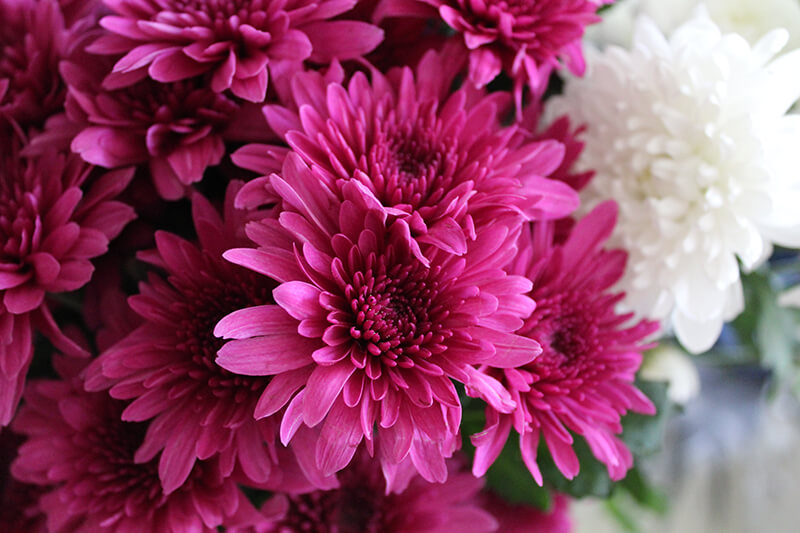
The chrysanthemum is unquestionably the flower of autumn, just as the azalea is the flower of spring. This plant is known for its brightly colored domes of flowers that bloom in the fall. If properly cared for, the plant can last for years. Despite being sold as fall decor, the plant is actually a perennial. In Asia, chrysanthemums are a popular choice for birthday and baby shower gifts. In Europe, the chrysanthemum is given in sympathy. A red chrysanthemum is a symbol of love if it is given to you by someone. Generally speaking, chrysanthemums are associated with happiness, love, and longevity. A herbaceous perennial, it can reach a height of three feet in height. It prefers a rich, moist, slightly acidic soil with plenty of direct sunlight. It’s best grown in zones 3 through 9, where it blooms in the late summer and early fall. Whenever the top inch of soil feels dry, or until the pot or soil feels moist, it should be watered.
6. Anemone (Anemone spp.)
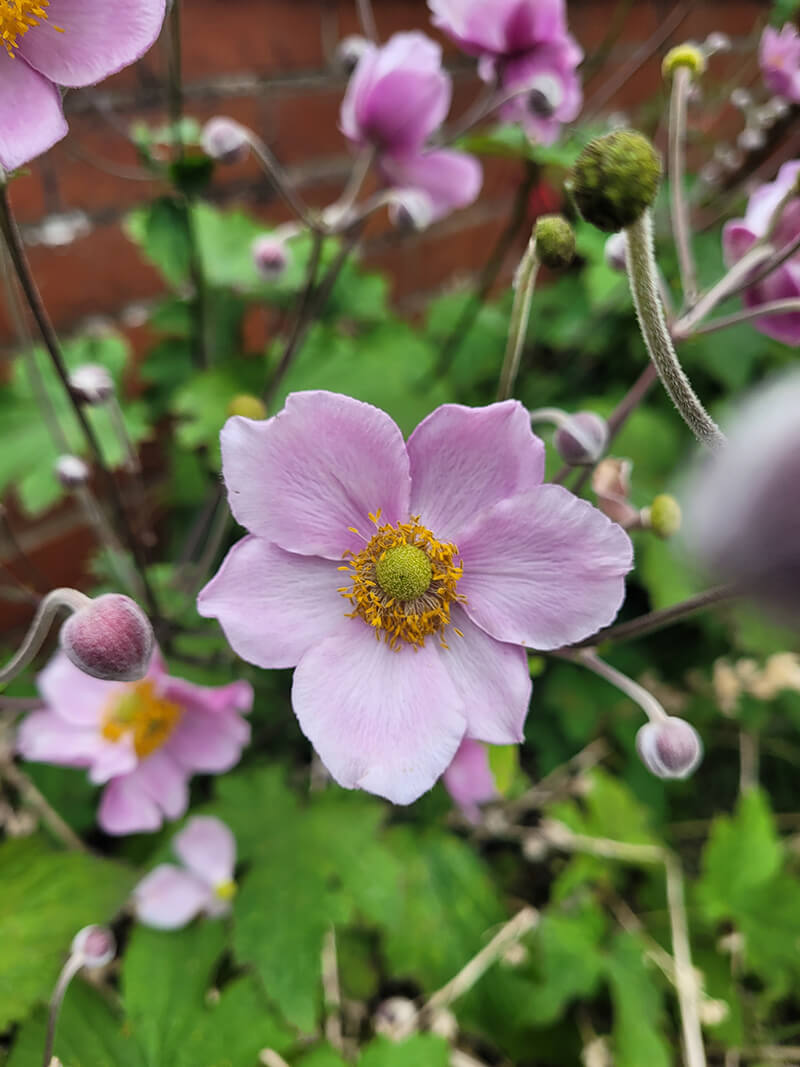
There are many species of plants in the anemone family, most commonly known as windflowers, that fall under the umbrella of the anemone genre. It’s not uncommon to see two-inch-wide flowers on anemone plants. Pink is a popular color choice, but other hues are also available. Anticipation is the most significant anemone flower symbolism. According to the Victorian flower lexicon, anemone flowers also represent vulnerability. In Greek and Christian mythology, the red anemone represents death or the act of forsaken love.
A corm resembling a bulb is the source of these fast-growing plants. The plant grows outward rather than upward, with a diameter of up to three feet and a height of about half a foot. Full to partial sunlight is preferred by this herbaceous perennial. Moisture-rich, acidic or neutral soil is ideal. It can bloom at any time of year, from spring to fall, depending on the species, and it can produce a wide variety of colors in its flowers. If not exposed to rain, it does best in zones 3 to 10 and needs to be watered on a regular basis. Make sure you know the water requirements of the species you’re working with.
7. Cherry Blossoms (Prunus Serrulata)
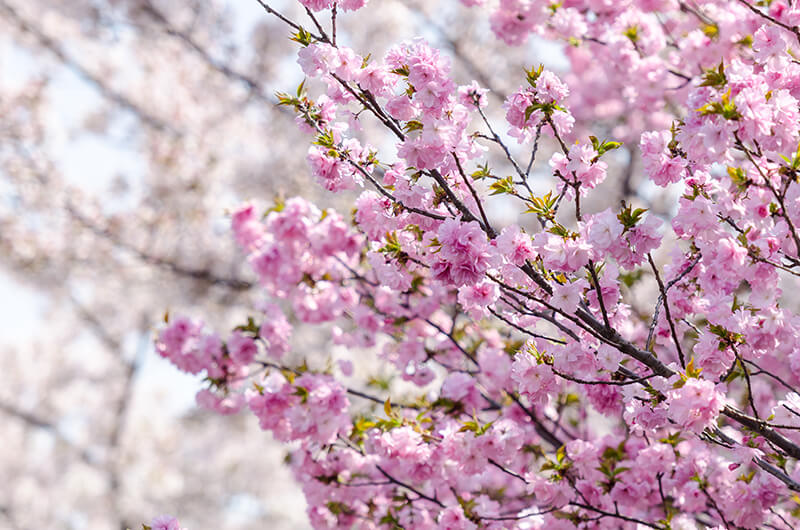
“Japanese cherry tree” is an umbrella term that encompasses a wide range of Japanese ornamental flowering trees. However, the two most common varieties are the Kansan and Sekiyama varieties, which are small and compact, making them ideal for landscaping. White or pink flowers bloom in early spring, though the trees are planted in the fall before the first frost so that they have time to grow roots before winter. This plant’s small amounts of cyanide make it mildly toxic to both humans and animals, and this should be taken into consideration when handling any part of the plant.
In Japan, cherry blossoms are a sign of spring, a time of rebirth, and a reminder of life’s transience. Their flowering time is extremely limited. As a deciduous tree that can reach 25 feet in height, it needs full sun exposure to thrive. Loamy, well-draining soil with a pH of 7 or higher is ideal. During the spring, it produces pinkish blooms and thrives in zones 5 through 8. It is native to Japan, Korea, and China, and requires a lot of water to thrive. If it doesn’t get at least an inch of rain a week, it needs to be watered. It is drought-tolerant for a short time, but it needs to be mulched to keep its roots moist.
8. Oriental Lily (Lilium ‘Stargazer’)
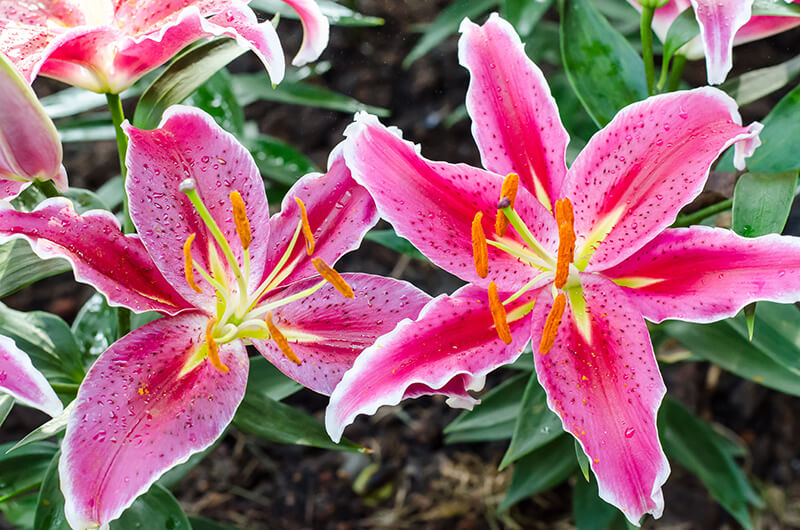
There are many different varieties of the “Stargazer Lily,” or Oriental Lily, which were created in the 1970s by combining the best characteristics of a few different Asiatic lilies. It has large, fragrant, bowl-shaped types of pink flowers that bloom in the middle to the end of the season. The flower can grow to a diameter of six inches and has a strong fragrance that can be overpowering to some. In general, the colors are bright and typically red, with pink being the most popular.
Their nectar attracts butterflies and hummingbirds, which makes them an excellent addition to hummingbird gardens. Although it is most commonly planted in the fall, it can also be planted as soon as the ground thaws in early spring. Because of their association with the Virgin Mary, oriental lilies have come to represent purity as well as new life. Perennial bulbs can grow up to four feet tall, and they need full sun and moist, well-drained soil in order to thrive. It prefers a slightly acidic soil and will bloom during the summer months. Zones 4 through 9 are ideal for this pink flower plant, and it should be watered when the soil feels dry, but the bulb can rot if left in standing water.
9. Camellia (Camellia spp.)
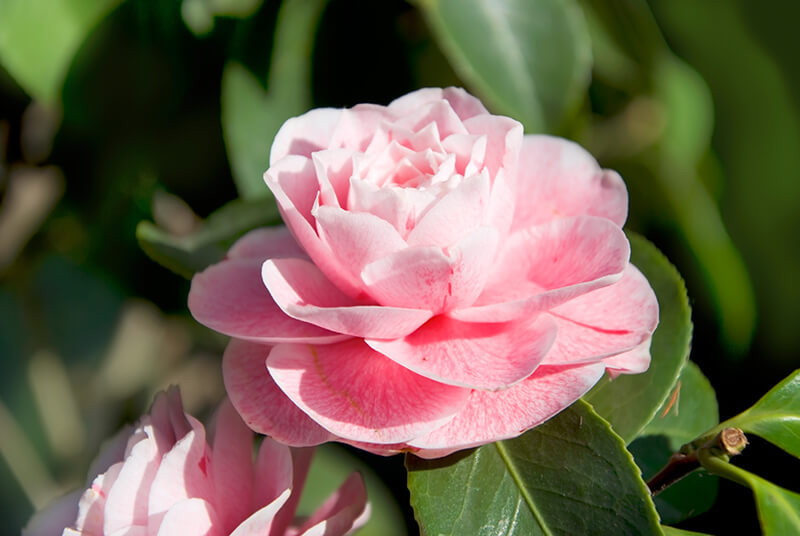
For more than 1,000 years, humans have been cultivating this flowering shrub, which is most commonly found in the southern United States, though it was originally native to Japan and China. Despite the fact that camellias belong to the tea plant family, they resemble the peony. They can be planted at any time of year, except for the hottest months of summer, because they are hardy and versatile. Flowers come in a variety of hues, with pink being the most common, but they are evergreen and produce white, pink, and red blooms. Brother Josef Kamel, a Jesuit priest from the Philippines, was the first European to cultivate it. Camellia flowers are often used as a metaphor for feelings of love, adoration, and admiration. It prefers partial shade and can reach a height of twelve feet. Soil with a pH of between 5.5 and 6.5 is ideal for growing this plant. It blooms from late fall to early spring in zones 7 through 9, with good success.
10. Foxglove (Digitalis Purpurea)
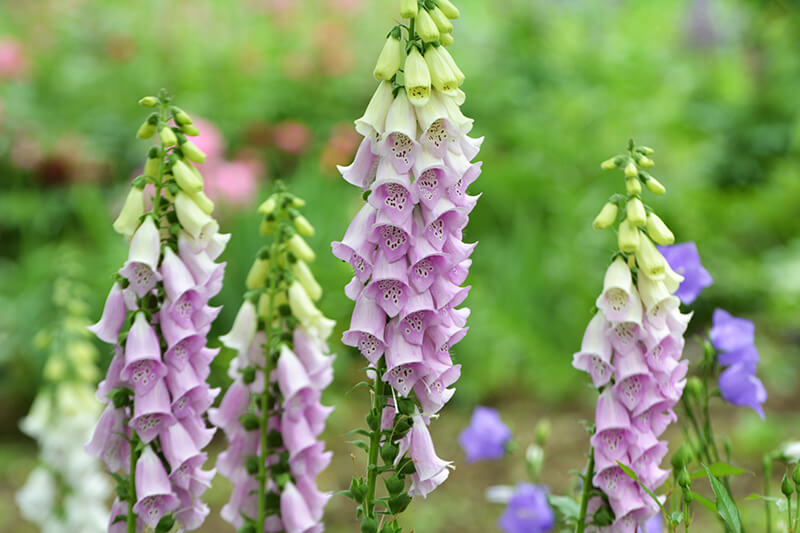
Digitalis purpurea, a species of the digitalis genus that produces tubular, brightly colored blooms in shades of pink to purple, is the most commonly known foxglove. In its second year, it produces a large clump of foliage, but in its first year, it only produces a few leaves. While two feet is the norm, the stalks can reach five feet in height when they are in bloom. All parts of the purple flower contain compounds that can affect the heart, making the plant itself quite toxic.
Insincerity is frequently associated with the flowers, and their meanings can be both hurtful and healing. They can also represent pride, energy, magic, ambition, intuition, and creativity, among other things. Full to partial sunlight and loamy, well-drained soil are ideal conditions for this biennial. It prefers a slightly acidic soil and blooms in the first half of the summer. It is indigenous to Europe and Africa and thrives in climates ranging from zones 4 to 10. To avoid root rot, good drainage and moistened but not saturated soil are essential. Water only when the top 2 inches of soil are dry.
11. Peony (Paeonia Officinalis)

Camellias and azaleas are the springtime harbingers in the South, but peonies are the springtime harbingers everywhere else in the United States. Peonies are herbaceous perennials with medium-sized tubular roots that can be delicate when transplanted, and there are an estimated thirty-three different species of pink flower plant. Even though they’re planted in the fall, they bloom from late spring through the summer. After six weeks, the plant will be ready for the first freeze.
Intricately detailed pink flowers that bear a resemblance to roses are produced. For centuries, the peony has been given as a symbol of goodwill and happiness on special occasions such as weddings, birthdays, and anniversaries. It requires a location with direct sunlight and soil that drains well. It thrives in climates ranging from zones 3 to 9. In some species, it can be mildly toxic to pets and humans. It is native to Asia, Europe, and North America, depending on the species.
12. Carnation (Dianthus Caryophyllus)
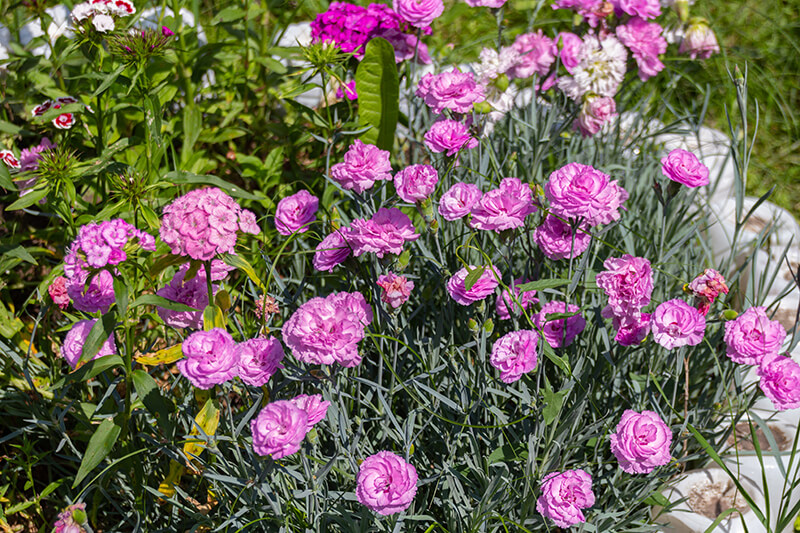
Carnations, one of the most popular perennials for bouquets and corsages, can be found in most flower shops around the world. It’s not uncommon to see white carnations dyed a specific color for special occasions like holidays, including pink, coral, and red. People have been growing the plant for over 2,000 years, but no one can pinpoint its origins, not even the most ancient of writings. It is believed to be an Italian, Spanish, or Greek original. Carnations are also a symbol of love, in addition to devotion.
Carnations make a lovely gift for many occasions, such as Mother’s Day, a birthday, or an anniversary, whether it’s for a family member, a romantic partner, or a close friend. It is not uncommon to see them arranged in funerary arrangements to represent loss or mourning. It is possible for carnations to reach a height of approximately one foot and a half and to thrive in both full sun and partial shade. Alkaline and well-drained soil are essential. In late spring, it bursts into full bloom, but it can also rebloom in the summer. For best results, water it regularly when it is forming buds. It thrives best in zones 7 through 10. It’s better to water at the base of the plant, but overwatering can make the leaves turn yellow.
13. Geranium (Geranium spp.)
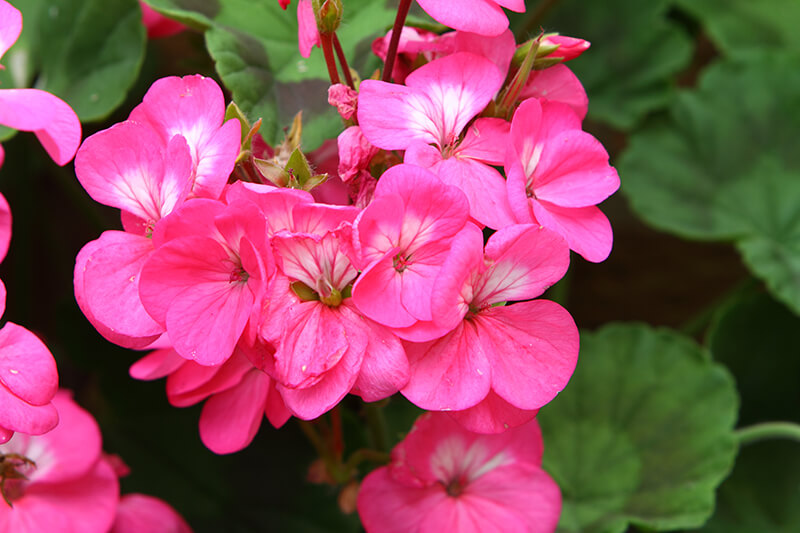
With a wide range of species and hybrids developed over the course of centuries, the popular geranium is able to thrive in a wide range of environments and climates. The most popular geranium varieties are those that produce dense pink flower plant stalks that creep among other plants and produce flowers in every color between white, magenta, and blue. Currently, hybrids are more common than true geranium species. They attract butterflies and are used in a variety of landscaping designs.
According to folklore, geraniums are a symbol of joy, companionship, and good health. Many people give them as housewarming gifts because of this. It’s a showy perennial, growing up to two feet tall. This plant prefers well-drained, slightly acidic soil and varies from variety to variety depending on how much sun or shade it gets. Depending on the variety, it blooms from spring through fall and thrives in climates ranging from zones 3 through 9. It can be found all over the world, but it is most commonly found in the Mediterranean region. Even in full sun, it only needs to be watered when the soil has dried out.
14. Hollyhock (Alcea spp.)
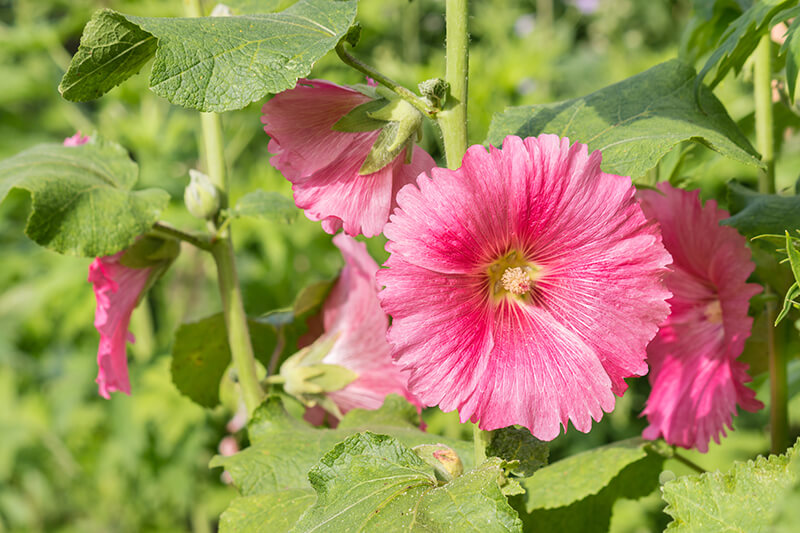
Hollyhocks are an old favorite in cottage gardens because they come in more than sixty varieties. Once or twice a year, these plants bloom with deep vibrant magenta and pink flowers, reaching a height of up to eight feet though four is more common. Bees and other pollinators are attracted to some varieties, making them a wonderful addition to a butterfly garden. There are many meanings to be found in the symbolism of hollyhocks. Planting them at the entrance to a home is considered a sign of good fortune. The mummified of Egypt were often given hollyhock wreaths to help them on their way to the afterlife. Depending on the soil’s acidity or alkalinity, it can be grown in full sun or partial shade. Keep the top five inches of soil moist, but not sopping wet that roots begin to rot. It thrives in zones 2 through 10, and its flowers are best seen in the summer months. It’s a native of both Europe and Asia.
15. Calla Lily (Zantedeschia Aethiopica)
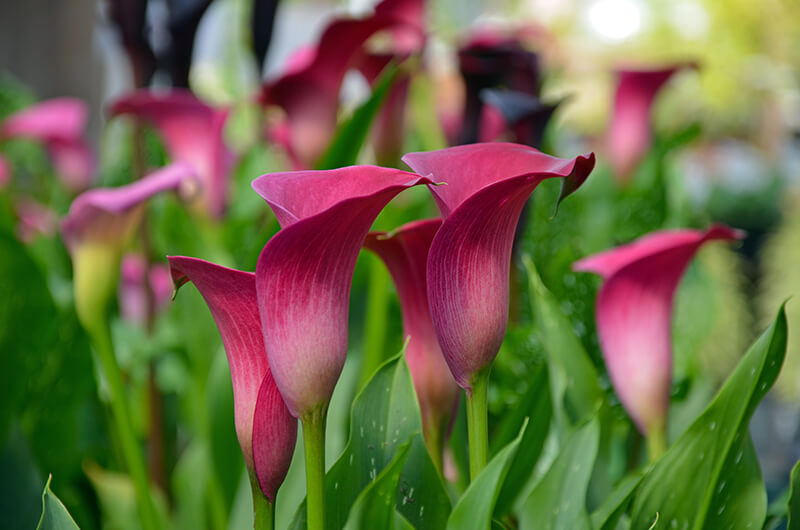
Calla lilies, known for their grace and beauty, are a common sight in bouquets and classical gardens alike. White and pink are the most popular colors, but it can bloom in a variety of hues. Even more recently, some hybrids have even produced genuine colors of black and orange flowers. Once cut, they can last for a long time, making them a popular choice for bridal bouquets. Native to Africa, calla lilies are usually planted in the springtime in gardens and homes across the country.
Midsummer to early fall is when they bloom, and they are poisonous to both humans and animals. In Easter services, white calla lilies have come to symbolize the resurrection and rebirth of Jesus Christ. White calla lilies, like yellow calla lilies, convey innocence and gratitude. The meaning of the pink calla lily is one of admiration and respect. Purple calla lilies are a symbol of passion. Growing in full sun or partial shade, the rhizome of this plant can reach a height of three feet. The soil should be kept moist but well drained, and it should also be acidic. Once a week if it isn’t kept in dry conditions, this plant is hardy in zones 8 through 10.
16. Zinnia (Zinnia Elegans)
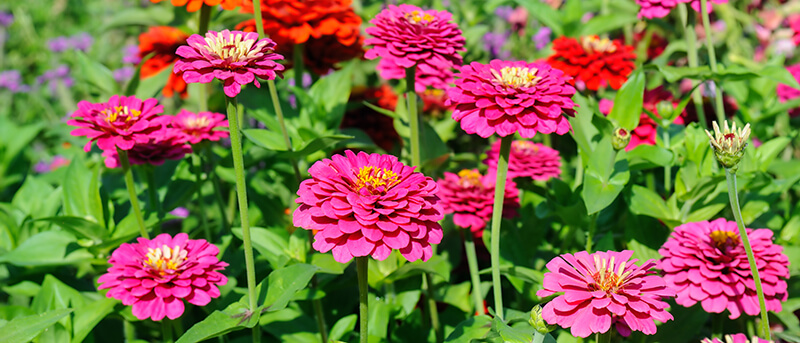
Although native to South America and Mexico, zinnias are now widely grown around the world for their bright pink hues and low maintenance requirements. In addition to their rapid growth, annual flowering, and a wide range of colors, they are constantly being improved upon by cultivators by introducing new hybrids. They can thrive in some of the most difficult conditions, and the flowers look a lot like daisies. These plants love hot weather and should be planted in the spring, though they only really start to grow when the weather is warm.
There are many different meanings associated with the zinnia flower, but it is most commonly associated with friendship and endurance. Zinnias were popular in the Victorian era as a symbol of longing for a long-lost friend. As annual shrubs, they can reach a height of four feet and require full sun to thrive. In the late spring, they should be planted in neutral, well-draining soil that requires only occasional watering. The roots do not do well when constantly damp.
17. Hydrangea (Hydrangea Arborescens)
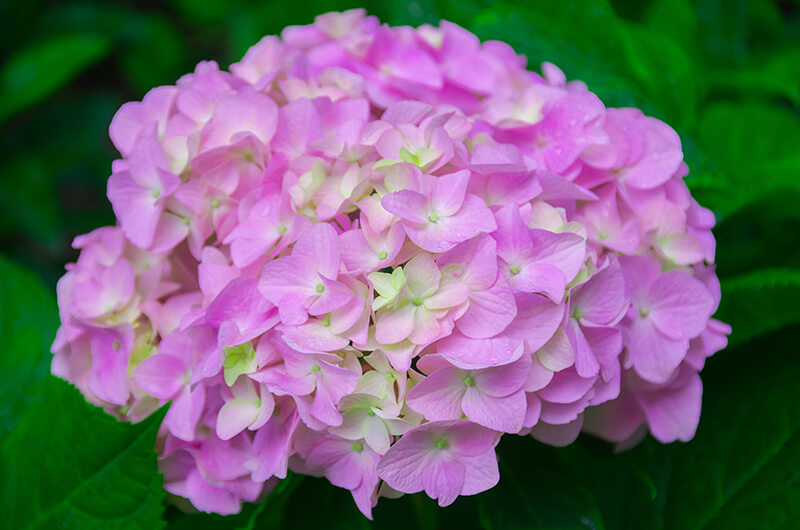
Although only a few species of this genus are used in gardening, this deciduous shrub is one of the most well-known in cottage gardens. When compared to other flowering plants, it puts out a lot of beautiful blooms and grows quickly. Although they can reach heights of up to ten feet, they are usually no more than three feet in height. This pink flower plant symbolizes gratitude, grace, and awe-inspiring beauty. Also, because of the abundance of flowers and its generous round shape, it radiates abundance. Love, harmony, and peace are all embodied in its vibrant hues. It can tolerate mildly acidic soil, but it prefers well-drained, alkaline or neutral soil. It is native to the eastern United States and blooms in the summer. Because it thrives in moist environments, irrigation is necessary if it is to be grown in arid regions. Keeping the soil moist but not waterlogged is essential.
18. Hibiscus (Hibiscus)

The hardy hibiscus is one of the most popular pink-flowered tropical plants for those who enjoy tropical plants. On this North American native, there are many different shades of pink to choose from. The flowers are large and delicate. Their spring planting is followed by summer blooming; some of the flowers are as large as Frisbees. Bees, butterflies, and hummingbirds, as well as dragonflies, enjoy the flowers. In general, the flowers only last two days, but because they bloom multiple times, they are quickly replaced. Many people believe that yellow hibiscus brings happiness, sunshine, and good fortune.
The red hibiscus is a symbol of passion and love. This flower is a symbol of friendship and love in many forms. They grow to a maximum of seven feet in full sun, though most grow to a height of three feet or less. Potting soil rich in nutrients can be used as long as the soil is acidic to neutral. Zones 5–9 are suitable for its cultivation and should be kept watered but not overdone. It needs around two inches of water per week, or every other day in hot, dry climates.
19. Spider Lily (Lycoris)
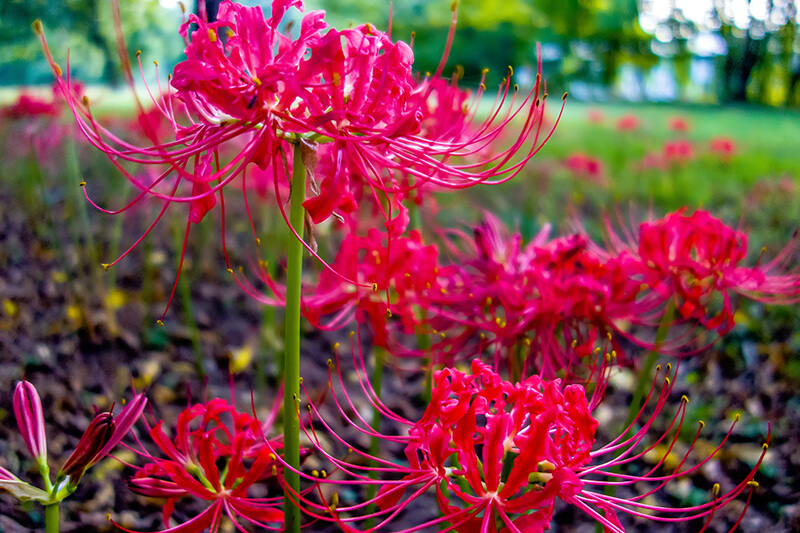
The spider lily produces thin petals at the end of long stems that resemble fireworks, and can reach ten inches in height. Colors range from white to red to pink in the late summer blooms of this plant. As an amaryllis rather than a lily, some varieties can go dormant in the summer and re-bloom in the fall or winter, depending on the climate where they live. They’re easy to grow, and they’ll come back year after year. Bright summer flowers, spider lilies are native to Asia and can be found throughout the continent.
The legend goes that these flowers grow in places where people part ways for the last time. Red spider lilies have long been associated with samsara, the cycle of rebirth in ancient Buddhist texts. They require either full or partial sun, as well as alkaline soil that drains well. They are native to China and Japan, and thrive in zones 6 through 9. The soil should be moist but not saturated for this plant, which has only moderate water requirements. Over-watering spider lilies is a common cause of bulb rot.
20. Hyacinth (Hyacinthus Orientalis)
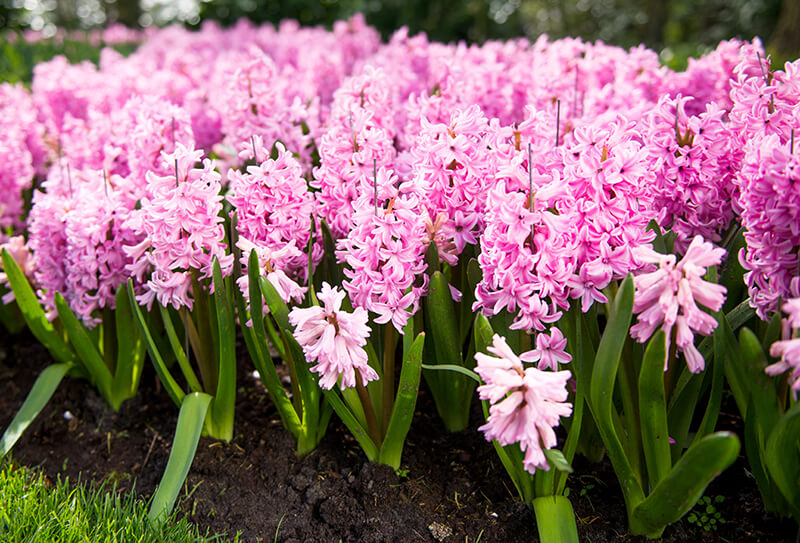
It’s common knowledge that the hyacinth is a plant that produces blooms with a strong scent, which can often conjure up feelings of spring in those who are familiar with them. These tubular flowers come in a variety of colors, from white to blue to pink, emerging from the growth of spikes from which the petals are formed. It is originally from Asia but was brought to Europe in the 1700s by Dutch growers who began cultivating more than sixty different varieties of bulbs. They are low-maintenance perennial bulbs that can grow in pots or in the ground. As a rule, they should be cultivated in the fall and flower in the spring.
Because they are toxic to animals and people alike, the bulbs must be handled with extreme caution. The flower of the sun god Apollo, the hyacinth, is a symbol of peace, commitment, and beauty, but also of power and pride. It’s common to see hyacinths in Christian churches as a representation of joy and love. Growing to a height of one foot, it can thrive in either partial shade or direct sunlight. Well-drained and moist soil with a neutral pH level is ideal. As a general rule, it does best in zones 4 through 8, and the bulbs need to be watered thoroughly after planting. The ground should be allowed to dry out before spring and then watered twice a week, depending on rainfall, once the flowers begin to bloom.
21. Snapdragon (Antirrhinum majus)
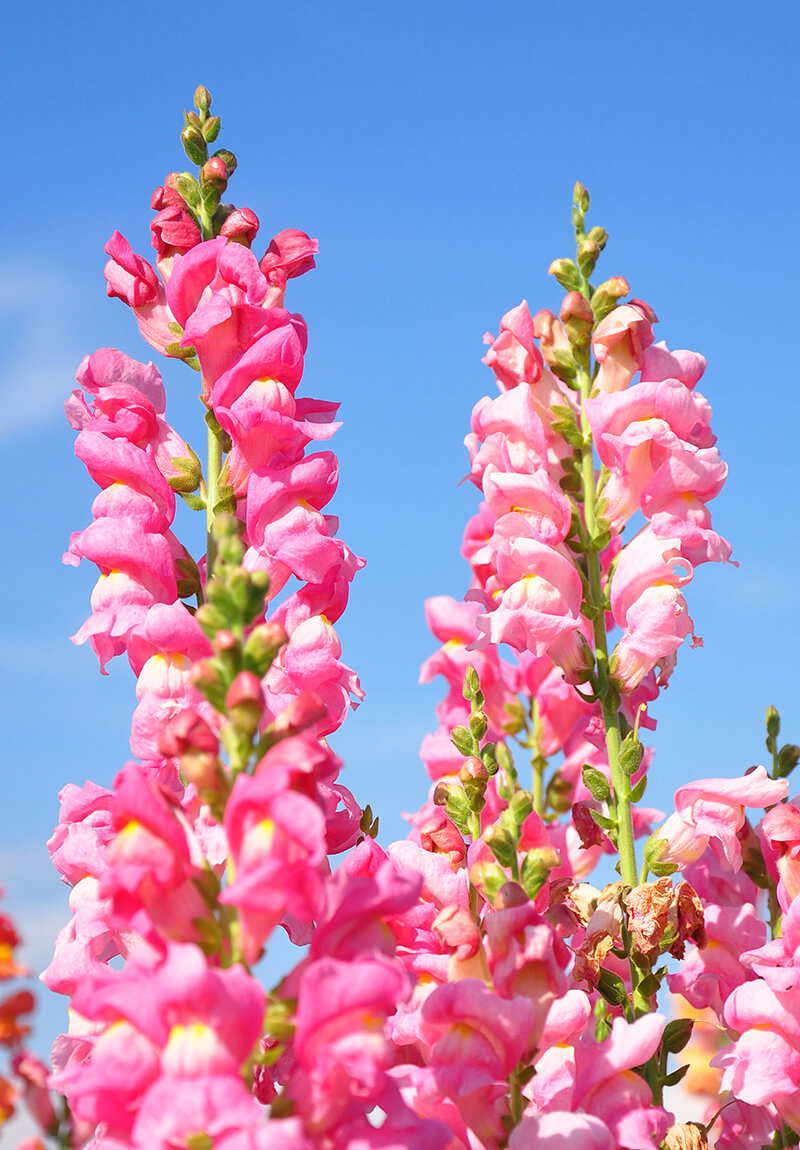
Although somewhat short-lived, the beautiful snapdragon is a popular perennial that has a variety of uses, from being grown as a border to adding some color to container gardens. The plant gets its name from the shape of the flower, which is thought to resemble a dragon’s head. They are native to Syria, Turkey, and much of the Mediterranean, and can produce stalks as large as four feet, though only about one foot is common.
They tend to bloom during the cooler months of spring and fall, although the blooming time officially is between spring and fall, throughout the summer. According to folklore, snaking is both deceitful and gracious. Full sun and partial shade are both fine, as long as the soil is moist and well-drained. It can be grown in zones 7 through 11 if the soil is slightly acidic to neutral. As soon as the plant is established, it needs about an inch of water a week.
22. Tulip (Tulipa)

The tulip is one of those flowers that, like daisies, roses, and daffodils, is instantly recognizable even to people who aren’t familiar with flowers. Cup-shaped flowers in nearly every color of the rainbow can be found on the stalks of this perennial bulb. Tulips are one of the oldest cultivated plants, and there are thousands of varieties in the genus to choose from. Planting a variety of tulips that bloom at different times is a popular strategy among gardeners who use tulips. Gardeners in warmer climates must purchase pre-chilled bulbs because the bulbs must be chilled at least once during the winter.
Flowering occurs between April and May, when the plant emerges from the ground. Tulips are often associated with a deep and perfect love. It is capable of reaching a height of two feet and necessitates exposure to direct sunlight. Rich, well-drained and largely neutral soil is ideal for a garden. Water the bulbs thoroughly after planting them in zones 3 through 8 for best results. After this time, water the plant sparingly so that the natural rain cycles can provide it with the moisture it requires. Water every two weeks during periods of drought.
23. Fuchsia (Fuchsia)
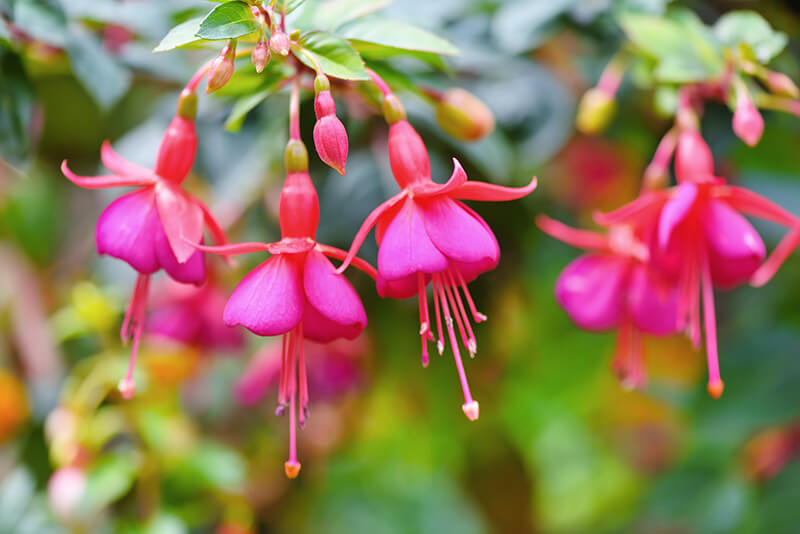
This is one of those flowers that catches your attention and makes you look twice. This annual shrub produces teardrop-shaped flowers in a variety of vibrant and cool colors. The most common colors are red and pink. With their bell-shaped buds hanging from a hanging basket, fuchsias are perfect for creating a chandelier-like effect. It is not recommended to plant the plant in areas where the nighttime temperature drops below 50 degrees Fahrenheit because of its high sensitivity to cold.
Depending on the culture, this flower can denote a loving and trusting relationship as well as a warning. Full and partial shade are ideal for this plant, which can reach two feet in height. Keep the soil moist but drain it well, and it can range from acidic to neutral in acidity. Late spring, summer, and early fall are the best times to see this plant’s red and pink flowers bloom. It thrives in zones 10 and 11 and is native to the Caribbean. It needs to be watered just enough to keep the soil moist but not soggy that it rots away. Because it thrives in moist environments, growing it in arid climates is unlikely to be a success.
24. Petunia (Petunia spp.)
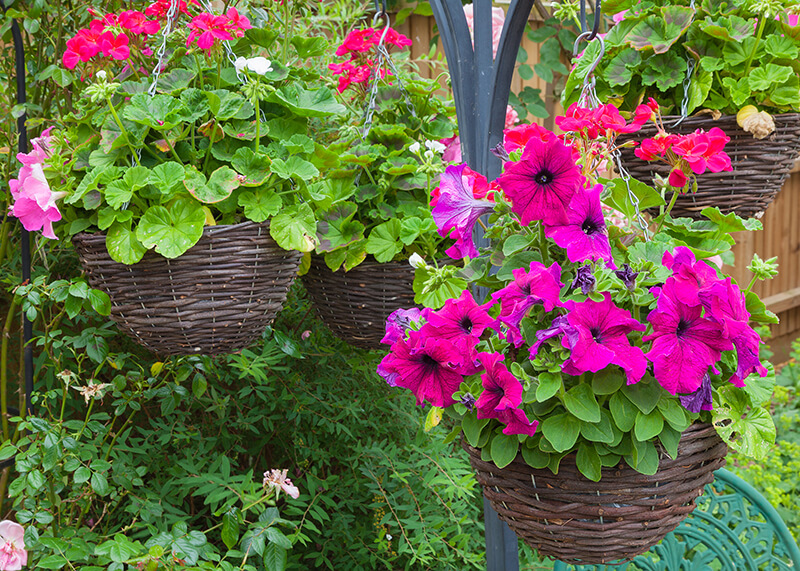
For gardeners of both border and container gardens, the unique petunia is a popular choice. This annual plant blooms prolifically and in nearly every possible color. The flowers are trumpet-shaped, and many varieties and hybrids can be found. It is native to South America, but can be found worldwide. They start as seeds and grow fast, and should be planted after the last frost. They usually reach full size by the start of summer. The petunia is associated with a soothing nature, calming anger and resentment. It can grow up to two feet tall and prefers full sun and well-drained acidic soil. It blooms primarily in spring and summer and grows best in zones 10 and 11. It should be watered often enough to keep the soil moist, as dryness can be fatal to the plant, but so can sogginess. It should get about 1 to 2 inches of water weekly, and the soil should not be allowed to dry out more than two inches deep.
25. Lotus (Nelumbo)
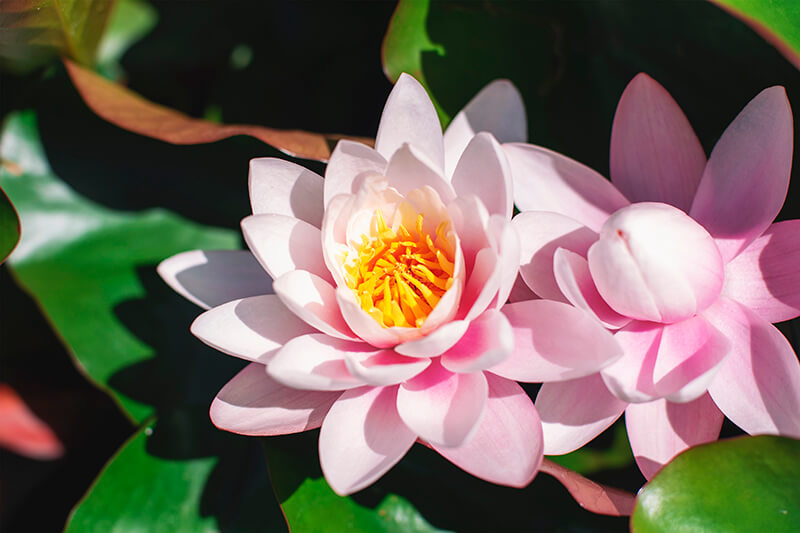
Water gardening is its own specialized springtime gardening pursuit, and the water-dwelling lotus is the centerpiece of any good water garden. The lotus has been revered across many cultures and religions for its beauty and otherworldly qualities. They are easy to grow and come in a variety of colors, the most common being white and pink. They produce fragrant blossoms between June and October, needing plenty of sun and warmth to induce flowering. They do not grow well in containers, although some have managed it, but rather ponds and pools work better.
The lotus shows up in many different cultures, particularly eastern religions, designating purity, enlightenment, and rebirth. It is a herbaceous perennial that can grow six inches tall and up to four feet wide. It needs full sun and neutral top soil or water conditions. It blooms mostly in the summer and prefers zones 4 through 10 for hardiness. It is native to Asia and Australia, and can be grown in baskets designed for water plants and should be kept wet. Ideally, they should be grown in ponds, which eliminates the need for regular watering.
26. Orchid (Orchidaceae)
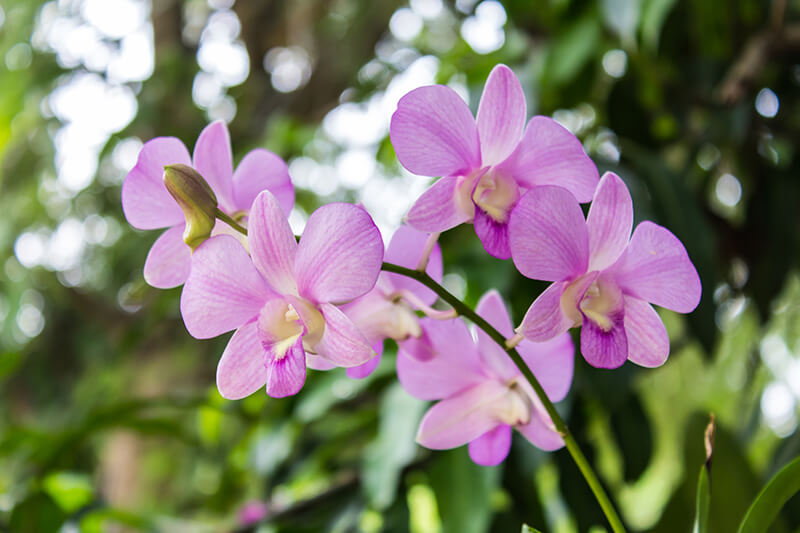
Orchids have a reputation for being difficult flowers to grow and maintain, and yet they are still some of the most popular houseplants around. They produce arching branches that are covered with delicate flowers clustered in groups of three. It is attractive to bees if kept outdoors, and some varieties grow faster than others. Orchids are typically associated with thoughtfulness, fertility, beauty, and love. It is a perennial herb that can grow to a foot and a half tall and likes bright but indirect light. It should be planted in a bark mix or sphagnum moss that is slightly acidic and is native to the United States and Thailand. It lacks an established hardiness zone because it is frequently grown indoors, despite the fact that it is a tropical plant in its native habitat.It doesn’t need much water, as the roots are adapted to drawing moisture from its surroundings, hence the need for well-draining moss. It should have alternating periods of dryness and watering, in which it can be watered weekly.
27. Begonia (Begonia Semperflorens)
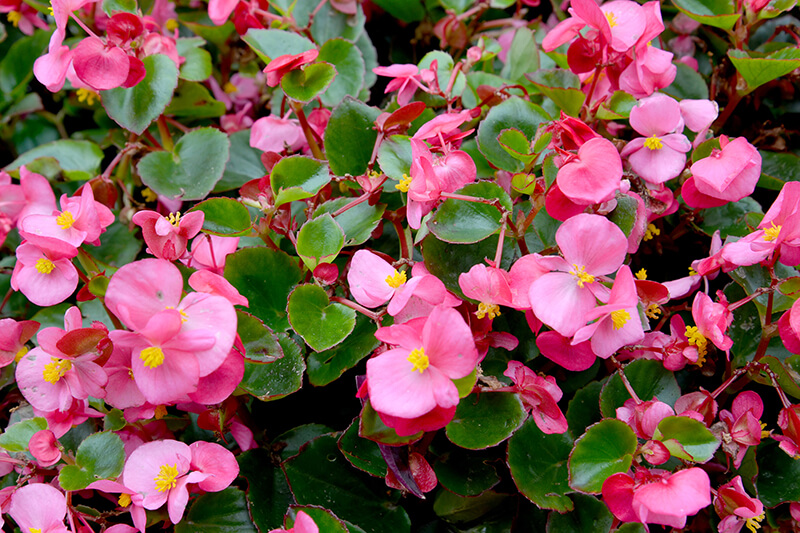
This unique plant, native to South America, is a popular potted plant that works well as an annual in colder locales and as a perennial in warmer locations. The leaves are waxy and glossy and can themselves come in a variety of colors, from green to maroon. The flowers are usually white, red, or pink, and the plant itself is relatively low-maintenance, needing only occasional pruning. The Begonia is a sign of warning about future misfortunes. However, it has also been used as a symbol of respect and gratitude. It can grow up to a foot and a half high and likes either partial shade or full sun. The soil should be rich, well-draining, and neutral. It blooms mostly in the summer and prefers zones 10 through 11. It needs regular watering and the soil should be kept damp, though over-watering can cause root rot.
27 Pretty Pink Flower Ideas that will Make Your Garden Bloom
Adding a pink flower plant to your garden now that spring is just around the corner is a great way to bring a touch of sweetness and romance to your garden’s color scheme. Plants with pink flowers are easy to grow and require little specialized attention, but careful planning is needed to ensure that the correct needs are being applied to each plant, and that those requiring shade are not planted in full sun, depending on the layout of the garden in which they are located. The awakening of the earth from its long winter’s sleep ushers in a season of renewal and joy, and a riot of pink flowers is a great way to greet it.
